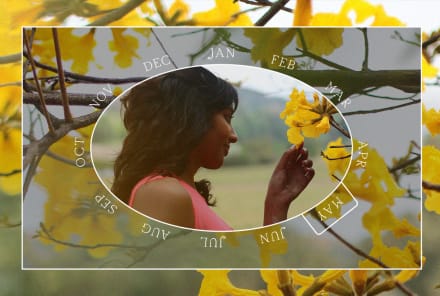Advertisement

I was driving in New Orleans early one morning when I heard a voice that told me to slow down. I was approaching an intersection, and fortunately I listened to that voice and I did slow down, because a huge truck ran a red light on a cross street, missing me by inches. If not for that voice, I would have been killed.
Since that day, I’ve been determined to find out what that voice was, where it came from, and why my life was saved. My search turned into a five-year journey that took me to some of the most remote and sacred places on the planet, to talk to holy men and mystics, sadhus and saints, research scientists and quantum physicists and psychiatrists. The result of this journey is documented in my new film, PGS-Intuition Is Your Personal Guidance System.
My research has taught me that intuition is a legitimate functioning bodily system that’s designed to protect us and guide us through life. It’s as legitimate as any of our other bodily systems, such as our circulatory system and immune system—it’s just that it lies within the energetic realm, connecting through to our physiological selves.
During the making of the film, I’ve come to believe certain things about how intuition works, why it works in the manner it does, and how we can access it to make better decisions so that we can live our life’s purpose. Here are five foolproof steps for tapping into your intuition:
1. Be willing.
First, you have to want to access your intuition. And for that to happen, you have to accept that intuition exists and that it can help you. That might seem obvious, but with a lot of people who profess to wanting to become intuitive, when you scratch the surface, they don’t really believe in it—and they’re not willing to take the steps required to develop it.
Everyone has intuition. We’re born with it, just like we’re born with a heart. Or a brain. We exercise our heart, we exercise our brain, we also need to exercise our intuition. But we have to be willing to do that. And that means stepping outside of ego, embracing humility, and accepting that intuition exists to help guide us to true fulfillment.
2. Stop and listen.
Once you state your intention to become more intuitive—and I say more intuitive because we’re all intuitive all the time, it’s just that it’s so ordinary we don’t even realize that we’re being intuitive—but once you state your intention, the next step is to stop and listen.
You need to stop, unplug, disconnect, and embrace stillness. Only then will you be more able to listen to those intuitive whispers that come from your soul. Stopping doesn’t necessarily mean sitting in a cave, adopting the full lotus, and going into a deep meditation. Stopping could mean a walk in the woods, listening to relaxing music, having a shower or bath, going for a swim in the sea. Doing something that helps disengage your rational brain, allowing you to connect with your intuitive self.
Listening also isn’t necessarily the classic definition of listening. Listening really means becoming more attentive, and paying attention is a big step in becoming more intuitive.
3. Pay attention.
Your intuition tries to connect with you in myriad ways, but for you to receive those messages, or signs, you have to pay attention, and that’s the first step to developing your awareness. Your awareness is one of the major tools in your intuitive toolbox. Without a finely honed level of awareness, you can never hope to connect in to your system of divine guidance.
4. Embrace wonder.
For me, a big step in becoming intuitive is that you have to embrace wonder. You have to nurture your sense of awe. You have to be comfortable with the notion that there are things that happen in this world that make no rational sense, that can’t be proved scientifically, yet that doesn’t mean they don’t exist. Our logical rational brain wants to sit in the comfort zone of quantifiable certainty that science provides. But for me, science is constantly playing catchup to what the sages and mystics told us thousands of years ago. So to become truly intuitive, you have to trust that "there are more things in heaven and earth than are dreamt of in your philosophy."
5. Surrender.
We talk about the need to trust our intuition, but to do that we have to be prepared to surrender, to let go. And that’s a big one, because that means letting go of control. We all want to control things because once again there’s safety; there’s certainty in clasping onto the known. But intuition resides in the unknowable, and it requires us to jump off the cliff and free-fall in the belief that there will be some kind of safety net underneath—that the divine won’t let us plummet to our demise; that we’ll be protected, and that, in fact, we will learn to fly. To do that, though, we have to surrender to the wisdom and love that is there for us in the realm of mystical intuition. Divine intuition. Our soul’s guidance system—that’s there for us all.
Want more ideas for tapping into your intuition? Here are 18 ways to make it happen.
Watch Next
Enjoy some of our favorite clips from classes
Enjoy some of our favorite clips from classes
What Is Meditation?
Mindfulness/Spirituality | Light Watkins
Box Breathing
Mindfulness/Spirituality | Gwen Dittmar
What Breathwork Can Address
Mindfulness/Spirituality | Gwen Dittmar
The 8 Limbs of Yoga - What is Asana?
Yoga | Caley Alyssa
Two Standing Postures to Open Up Tight Hips
Yoga | Caley Alyssa
How Plants Can Optimize Athletic Performance
Nutrition | Rich Roll
What to Eat Before a Workout
Nutrition | Rich Roll
How Ayurveda Helps Us Navigate Modern Life
Nutrition | Sahara Rose
Messages About Love & Relationships
Love & Relationships | Esther Perel
Love Languages
Love & Relationships | Esther Perel


















